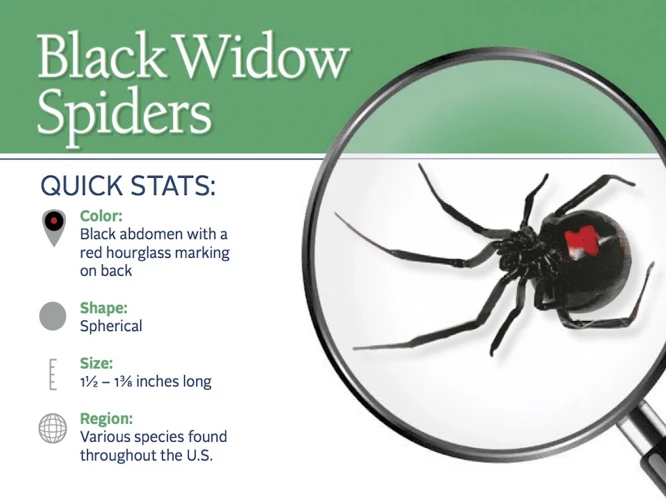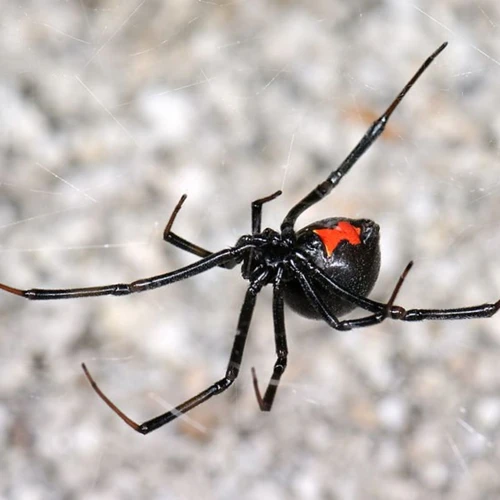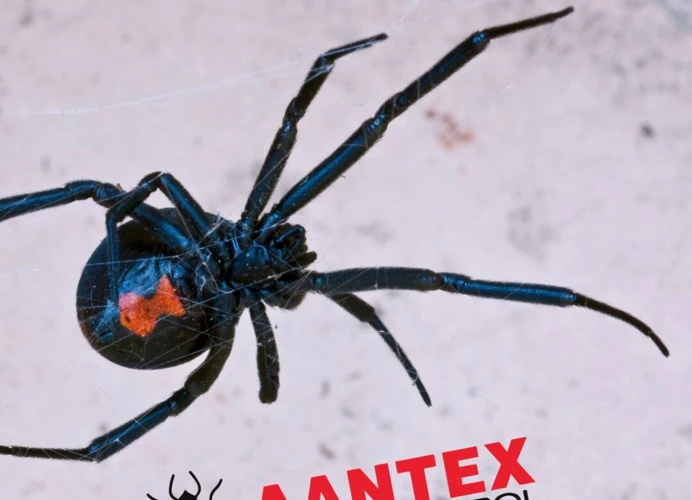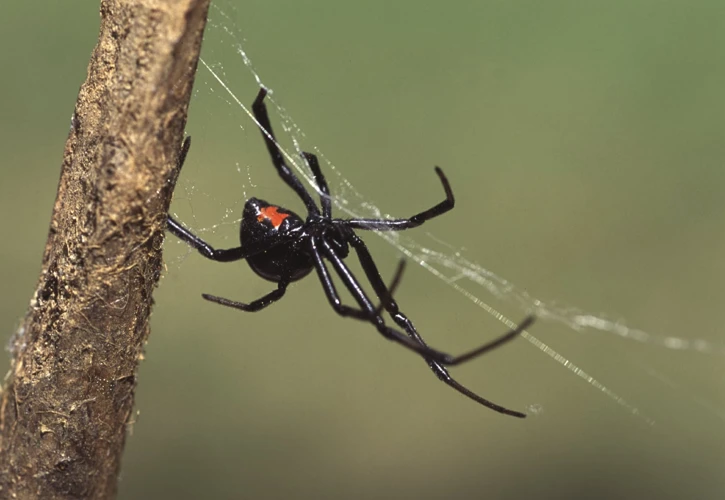As we explore the vast world of nature, we come across creatures that might frighten or fascinate us. One such unique creature is the Black Widow Spider. With its characteristic red hourglass-shaped mark, the Black Widow Spider is known for its venomous bite. However, did you know that having Black Widow Spiders in your yard can be beneficial? It may seem counterintuitive, but these spiders are natural predators and can help control the pest population, creating a healthy ecosystem. In this article, we will explore the ways to attract Black Widow Spiders to your yard and understand the safety measures to take if you decide to go ahead. So, let’s dive into the intriguing world of Black Widow Spiders and learn about 5 habits to attract them in your yard.
Why Attract Black Widow Spiders?

Why Attract Black Widow Spiders? It might seem counterintuitive to purposely attract one of the most feared and venomous spiders to your yard. However, black widow spiders can actually provide some beneficial value to your outdoor space. These spiders are known for their natural pest control abilities and can help to reduce the population of harmful insects in your yard. Additionally, by creating a habitat for black widow spiders, you can promote biodiversity and encourage a healthy ecosystem. But how do you go about attracting these spiders? Let’s explore some ways to create the perfect environment for black widows to thrive. If you want to learn more about black widow spiders and their habitats, check out the Black Widow Habitats article.
Natural Pest Control
Natural pest control is one of the biggest benefits of attracting black widow spiders in your yard. This is because these spiders are known to control infestations of other pests such as mosquitoes, flies, and cockroaches. By allowing black widows to exist in your yard, you are creating a natural balance in your garden that will help keep pests under control.
Here are a few examples of pests that black widow spiders can keep under control:
- Flies
- Mosquitoes
- Cockroaches
- Grasshoppers
- Caterpillars
Creating the ideal habitat for black widow spiders can also offer the added benefit of attracting other predatory insects that can help to control pest populations. For example, assassin bugs, which are attracted to the same habitats as black widows, are known to eat a wide variety of pests.
However, it’s important to remember that black widow spiders are not a complete solution to pest control and should only be a part of an integrated pest management plan. This ensures that your yard remains diverse and balanced ecologically, and that you don’t end up with an overpopulation of black widow spiders.
Here are a few things to keep in mind:
- Black widows should not be the sole method of pest control in your yard.
- Integrate black widows into a larger pest management plan.
- Consult with a pest control professional for best practices in pest management.
Understanding the importance of urban and rural black widows habitats is crucial for creating the ideal natural pest control environment in your yard. By creating the perfect environment, you’ll be able to attract the right types of predators and ensure that your yard remains a safe and balanced ecosystem. Ultimately, this will help to keep pests under control and create a healthier, more sustainable garden for you and your family to enjoy.
Biodiversity
Biodiversity plays an important role in creating a balanced and healthy ecosystem in your yard. By attracting black widow spiders, you are contributing to the local biodiversity. Black widow spiders are part of the natural food chain and provide food for birds, reptiles, and other predators. They also help control pest populations and prevent the spread of diseases.
To promote biodiversity in your yard, you can create suitable habitats for black widow spiders by providing them with the right conditions to thrive. This includes avoiding the use of chemical pesticides and removing spider webs.
Another way to promote biodiversity is by evaluating soil factors and choosing the right plant species for your yard. According to the black widow habitat suitability index, the presence of organic matter, soil moisture, and vegetation cover are important factors that influence the presence of black widow spiders. By controlling vegetation and ensuring adequate moisture levels, you can create a suitable habitat for black widow spiders in your yard.
Here’s a table highlighting the key factors that promote biodiversity and a suitable habitat for black widow spiders:
| Factor | Description |
|---|---|
| Organic matter | Decaying plant material that provides nutrients and shelter for spiders |
| Soil moisture | Adequate moisture levels to support insect populations and provide drinking water for spiders |
| Vegetation cover | Vegetation that provides shelter and prey for spiders and supports the local ecosystem |
By promoting biodiversity and creating a suitable habitat for black widow spiders, you can contribute to a healthier and more sustainable environment in your yard. For more information on how to evaluate soil factors and assess the suitability of your yard for black widow spiders habitat, visit /evaluating-soil-factors-and-black-widow-spiders-habitat/.
Creating the Perfect Environment

Creating the perfect environment for black widow spiders involves understanding their natural habitat and behavior. These spiders tend to prefer dry and sheltered areas such as woodpiles, cluttered debris, and rocky crevices. However, they also require certain elements such as appropriate food sources and the presence of their webs and egg sacs. Creating a suitable home for black widows involves a combination of factors that need to be taken into consideration. Let’s delve into some specific ways to attract these spiders to your yard and increase your chances of spotting them. Additionally, we’ll explore what to avoid when trying to create the ideal environment.
Dry Shelters
Black widow spiders are usually found in secluded, dry and dark places. To attract these spiders in your yard, it is essential to create a suitable habitat by providing dry shelters for them. These dry shelters will serve as a hiding place for the spiders during the day.
Here are some ways to create dry shelters:
- Stack piles of rocks or wood in dry areas of your yard. This will provide shelter for black widow spiders to hide during the day.
- Install birdhouses or other small structures with small entrance holes. Black widow spiders can crawl into these structures and hide during the day.
- Place pots or planters upside down in dry areas of your yard. This will give black widow spiders a hiding place during hot or dry weather.
It is important to remember that these dry shelters should be placed in areas away from human activity to reduce the chances of accidental spider bites.
Creating a suitable habitat for black widow spiders in your yard can be an effective way to control pests like mosquitoes and flies. However, it is also important to maintain the ecological balance in your yard. You can achieve this by controlling the amount of vegetation in your yard and by providing natural sources of water for other wildlife.
Related Link: Moisture and Black Widow Habitat
Webs and Egg Sacs
Webs and Egg Sacs play a crucial role in the lifecycle of black widow spiders. If you’re looking to attract black widows to your yard, then providing them with a suitable place to spin their webs and lay their egg sacs is a must. Black widow females are known for their iconic, messy webs that are typically found in undisturbed areas. These webs are used to catch prey and can be found in dry shelters such as woodpiles, garages, sheds, and rock crevices.
While black widows use their webs to catch prey, they also create egg sacs on them to protect their young. These sacs are often found within or near the webs, and can contain up to 900 individual eggs. Providing areas for black widows to create their webs and egg sacs can increase the chances of them staying in your yard.
To attract black widow spiders, you can start by leaving undisturbed areas around the yard. These areas can include piles of leaves, wood, and other debris. Additionally, providing vegetation around their webs help provide the spiders with shelter from the elements and predators. Plants such as ivy, blackberries, and clematis are all perfect plant choices.
It’s important to note that black widows prefer an undisturbed habitat and can become aggressive when threatened. With that in mind, it’s essential to leave the webs and egg sacs undisturbed once you discover them. However, if it’s necessary to move them, it’s essential to approach with caution and move them to a secure, undisturbed location.
Pro Tip: To ensure a healthy population of black widows, it’s crucial to avoid using chemical pesticides in the yard. These pesticides can be detrimental to the spiders’ health and disrupt the ecosystem they inhabit. Instead, consider controlling vegetation by using organic methods or removing potential hiding places for other pests that may otherwise attract spiders.
Providing an environment that is suitable for black widow spiders to spin their webs and lay their egg sacs can help attract them to your yard. However, it’s important to ensure that the environment is safe for people and pets. Understanding the natural interactions of these spiders and their habitat is essential to maintain a healthy and balanced ecosystem. To learn more about the interactions of black widow spiders and their habitat, check out the Ecological Niche of Black Widow Spiders.
Food Sources
One important aspect of attracting black widow spiders to your yard is providing them with food sources. Black widows primarily eat insects and other arthropods, so it’s important to create an environment that is attractive to these prey species.
Table: Common Prey Species for Black Widow Spiders
| Insects | Arthropods |
|---|---|
| Flies | Centipedes |
| Mosquitoes | Millipedes |
| Beetles | Scorpions |
| Ants | Crustaceans |
Having a diverse range of prey species is important for maintaining a healthy ecosystem in your yard, and can help attract a variety of beneficial organisms. Another way to attract prey species is by controlling the vegetation in your yard. Pruning shrubs and trees can help open up the environment and create more opportunities for insects to fly and crawl around. For more information on controlling vegetation and other factors affecting black widow habitat, check out this article on habitat suitability for black widows.
It’s important to note that black widow spiders are not a guaranteed solution for pest control, and it’s important to consider other methods for managing pests in your yard. However, attracting black widows can contribute to a complex ecosystem that supports a variety of organisms. For more information on the ecological niche of black widow spiders, check out this article on black widow ecology.
Plant Choices
When it comes to plant choices for attracting black widow spiders, it’s important to look for species that can provide the specific conditions they need to thrive. A great option is American beautyberry, which produces beautiful purple berries that are a favorite food source for black widow spiders. Another good choice is lemon verbena, which has a strong lemon scent that can attract a variety of insects, including prey for black widow spiders.
Below is a table with more plant choices and their benefits for attracting black widow spiders.
| Plant | Benefits |
|---|---|
| Black-eyed Susan | Produces a lot of nectar, which can attract insects that are prey for black widow spiders. |
| Bottlebrush Buckeye | Produces flowers that can attract insects that are prey for black widow spiders. |
| Marigold | Produces a strong scent that can attract prey for black widow spiders. |
| Rosemary | Produces a strong scent that can attract prey for black widow spiders. |
| Swamp Milkweed | Produces flowers that can attract insects that are prey for black widow spiders, and can also provide a habitat for beneficial insects that can control other pests in your yard. |
It’s important to note that while these plants can attract black widow spiders, they can also attract other types of spiders as well as a variety of insects. This can create a more diverse and balanced ecosystem in your yard, helping to control pests naturally. However, it’s important to keep in mind that black widow spiders can be dangerous, so it’s important to take precautions and make sure you are familiar with the signs of a black widow spider bite.
In addition to planting the right types of plants, creating a suitable habitat for black widows should also include providing dry shelters and webs and egg sacs, and avoiding the use of chemical pesticides. For more information on black widow habitats, check out our article on the Black Widow Habitat Suitability Index.
What to Avoid

It’s important to understand what to avoid when trying to attract black widow spiders to your yard. While these spiders offer natural pest control and diverse biodiversity, there are certain things you should refrain from doing that could be harmful to both you and the spiders. By avoiding these actions, you can create a safe and enticing environment for black widows to thrive. Let’s explore some of the things you should steer clear of when trying to attract these arachnids.
Chemical Pesticides
Using chemical pesticides to get rid of pests can be harmful not only to the pests but also to beneficial insects like black widow spiders. Chemical pesticides can contaminate the spider’s food sources and may cause serious damage to their habitat. Instead of using chemical pesticides, consider natural pest control methods like introducing other beneficial insects, utilizing companion planting, and setting up physical barriers.
Removing spider webs with chemical sprays not only eliminates potential egg sacs and habitats for black widows, but it can also lead to them being displaced and forced to find new habitats. This can increase the likelihood of them coming into contact with humans and pets. Chemical pesticides can also be harmful to humans, pets, and other animals. It’s important to choose alternative, natural pest control methods that are both safe and effective.
Instead, consider using organic and natural insecticides, such as neem oil, which can be a safe way to control pests without harming beneficial spiders like black widows. But even with natural insecticides, it’s important to read the label and follow the instructions carefully.
Avoiding the use of chemical pesticides can be beneficial for both your garden and the black widow spider’s habitat. By using natural pest control methods, you can provide a healthy environment for your vegetation and beneficial insects. If you want to attract black widow spiders, it’s important to be mindful of the impact that pesticides can have on their habitat.
If you want more information on the topic, check out our article on interactions between black widow spiders and their habitat.
Removing Spider Webs
Removing spider webs may seem like a logical step in maintaining a tidy yard, but it’s important to consider the impact on the black widow spider population. These spiders construct their webs for protection and to catch prey, and destroying them can disrupt their natural habitat. While it may be tempting to remove spider webs, it’s important to remember that the removal of these webs can be detrimental to the balance of biodiversity in your yard.
Instead of removing spider webs, focus on removing any debris or clutter in the yard that may be providing shelter for other pests that attract spiders. Regular yard maintenance can help reduce the need for removing spider webs.
It’s also important to avoid using chemical pesticides, as they can be harmful to spiders and other beneficial insects in the yard. Chemical pesticides can also contaminate the water supply and have negative effects on human health. Consider natural pest control methods, such as introducing beneficial insects or using non-toxic sprays.
Remember that spiders, including black widows, play an important role in maintaining the ecological balance of your yard. By providing a suitable habitat and avoiding harmful practices, you can create a space where these beneficial creatures can thrive.
If you want to read more about creating the suitable habitat for black widow spiders, check out our articles about water sources in black widow spider habitat and suitable habitats for black widow spiders and why they are threatened.
Spider Safety Tips
When it comes to attracting black widow spiders to your yard, it’s important to keep safety in mind. Black widow spiders are venomous and their bites can be dangerous, especially for children and pets. In this section, we’ll go over some essential spider safety tips to help you identify and avoid bites, and keep your loved ones safe. So while it can be exciting to have these striking spiders in your yard, it’s important to approach them with caution. Let’s dive in and learn how to enjoy their presence safely.
Identifying and Avoiding Bites
Black widow spiders are known for their venomous bites, and it is important to be able to identify them in order to avoid potential harm. Here are some tips to help you identify these spiders and avoid their bites:
- Appearance: Female black widow spiders are shiny black with a distinctive red hourglass shape on their underside. Males and juveniles may have different markings, but are still mostly black.
- Location: Black widow spiders are commonly found in dark, dry places such as wood piles, garages, and basements.
- Behavior: These spiders are typically not aggressive and will only bite if they feel threatened. If you must handle something that may have black widows on it, wear gloves and use caution.
If you are bitten by a black widow spider, it is important to seek medical attention immediately. Symptoms can include muscle pain, cramps, spasms, and nausea. While many people can recover from a black widow bite with medical treatment, it can be fatal in rare cases.
To avoid being bitten, always wear protective clothing and gloves when working in areas where black widows may be present. Keep an eye out for their distinctive shape and avoid disturbing them whenever possible. Remember, prevention is key when it comes to staying safe around these venomous spiders.
Caution with Children and Pets
When it comes to attracting black widow spiders, caution must be exercised when it comes to children and pets. While black widows are unlikely to attack unless provoked, their venom is extremely potent and can be dangerous, especially for vulnerable individuals.
To minimize the risk of potential bites, it is important to inform children and keep pets away from known black widow habitats. It is also important to teach children to avoid touching spiders or their webs.
In addition to these precautions, homeowners should consider implementing physical barriers around areas where black widows are likely to be present, such as crawl spaces, garages and sheds. These barriers can consist of sturdy mesh or screen material that prevent entry of spiders and other pests.
Table of Safety Tips:
| Safety Tips | Description |
|---|---|
| Inform Children | Tell children about the dangers of black widow spiders and teach them to avoid touching spiders or their webs |
| Keep Pets Away | Make sure pets are kept away from known black widow habitats, especially places like crawl spaces, garages and sheds |
| Implement Physical Barriers | Use mesh or screen material to block off areas known to attract black widows |
By taking these precautions, homeowners can safely enjoy the benefits of having black widow spiders in their yard without exposing vulnerable individuals to unnecessary risk.
Conclusion
In conclusion, while attracting black widow spiders to your yard may seem like a strange and even dangerous thing to do, it can actually offer many benefits. By creating the perfect environment for them, you can enjoy natural pest control and increased biodiversity in your yard.
However, it is important to be aware of the potential risks and take necessary precautions. Avoid using chemical pesticides and be cautious when removing spider webs. It is also important to educate yourself and your family on how to identify and avoid bites, and to supervise children and pets during outdoor activities.
Remember, creating a welcoming environment for black widow spiders is just one step in promoting a healthy and balanced ecosystem in your yard. By taking the time to carefully select plants, provide shelters, and embrace natural pest control methods, you can create a thriving and sustainable outdoor space for all to enjoy. So why not give it a try and see the benefits for yourself?
Frequently Asked Questions
What are black widow spiders?
Black widow spiders are venomous spiders found in various parts of the world, known for their distinct black coloring and red hourglass-shaped markings on their abdomen.
Are black widow spiders dangerous?
Yes, black widow spider bites can cause serious health complications. Seek medical attention immediately if bitten.
What do black widow spiders eat?
Black widow spiders feed on insects, such as flies, mosquitoes, and grasshoppers, as well as other spiders.
How can I identify a black widow spider?
Black widow spiders have a distinct black coloring and may have red hourglass-shaped markings on their abdomen.
Where do black widow spiders live?
Black widow spiders prefer dry, secluded areas, such as woodpiles, sheds, and outdoor furniture.
Do black widow spiders live in all regions of the world?
No, black widow spiders are primarily found in warm climates, such as the southern United States, South America, and Australia.
How can I attract black widow spiders to my yard?
Attract black widow spiders by providing dry shelter, food sources, and planting insect-friendly plants.
How can I safely remove spider webs from my yard?
Avoid using chemical pesticides and gently remove spider webs with a broom or soft brush to prevent harming any spiders.
What should I do if I am bitten by a black widow spider?
Seek medical attention immediately if bitten by a black widow spider. Symptoms may include muscle cramps, nausea, and difficulty breathing.
Are there any precautions to take when attracting black widow spiders?
Exercise caution with children and pets around black widow spiders and keep outdoor seating areas clear of spider webs or spider-friendly areas.






